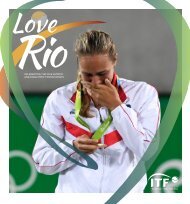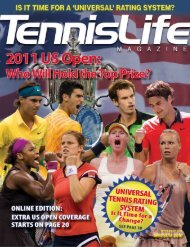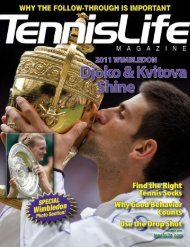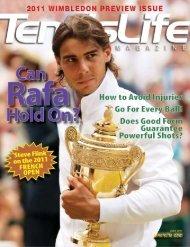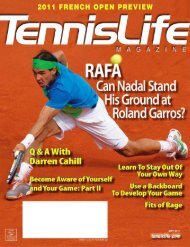A Champion's Mind - Pete Sampras
www.tennismoscow.me Insta:TENNISMOSCOW
www.tennismoscow.me Insta:TENNISMOSCOW
You also want an ePaper? Increase the reach of your titles
YUMPU automatically turns print PDFs into web optimized ePapers that Google loves.
I was so worn out by my push to break the consecutive-years-at-number-one record that I skipped the<br />
Australian Open, and was content to tread water through the spring events. I reached just one semifinal on<br />
my way to London’s grass courts, but then I won at Queen’s Club and entered Wimbledon with a chance to<br />
equal Roy Emerson’s record of twelve Grand Slam titles at the tournament I loved best.<br />
At this time, Andre’s final resurgence was in full swing. He made a huge statement at Roland Garros in<br />
1999, winning the title to become just the fifth man in tennis to post a “career Grand Slam” (winning each<br />
of the Grand Slam events at least once). I had a good draw at Wimbledon with a relatively easy first<br />
week. The demands of grass-court tennis created a smaller pool of contenders than you get at, say, the<br />
French Open, although the downside is that anybody with a big serve at Wimbledon threatened to upset a<br />
contender. It was hardly surprising to me when I saw that, just as in 1998, I would be playing Mark<br />
Philippoussis to get at (probably) Tim Henman in the semis.<br />
I knew that Philippoussis was getting ever more dangerous. The previous fall, his big forehand and<br />
powerful serve had carried him to the U.S. Open final. In our Wimbledon match, he was on fire in the first<br />
set, winning it 6–4. But he went down, hard, at 1–2 in the second set, and suffered a terrible knee injury<br />
that would severely impact his career.<br />
Henman was next, and at some level I felt for him. He was a class act; a friend, golfing buddy, and<br />
frequent practice partner. The British hadn’t produced a male Wimbledon champ since Fred Perry, and<br />
Tim was as close as they had come. He was always in the hunt, making the quarters or better, but the big<br />
upset, combined with a little luck in the way of opponents, always eluded him.<br />
Some pundits trashed Tim for not making that big breakthrough, but I felt that given the hopes of the<br />
Brits and the pressure that put on Tim, he not only handled the situation with great dignity, he actually<br />
played above his head at Wimbledon. I sat him down at the tournament myself three times (twice in late<br />
rounds), and the next best thing to winning a tournament is losing to the champion. People sometimes<br />
asked me if it was tough to douse my friend’s dreams as often as I did, and I have to confess: not one bit.<br />
It was like beating a buddy at darts, or a game of H-O-R-S-E. You just played, the better man won, and<br />
that was it.<br />
The last man standing between me and equal status with Roy Emerson was my main rival, Andre. It had<br />
rained on the Saturday women’s final, so the match between Lindsay Davenport and Steffi Graf was<br />
scheduled to finish on Sunday, as a prelude to our final.<br />
A Wimbledon final abounds in traditions and rituals that can really add to the pressure you feel before<br />
you go out to play. There’s that whole thing about having to wait in the small holding room, looking at that<br />
sign bearing the Kipling quote above the door. Then, when you’re finally sent on court, it’s with empty<br />
hands—an attendant carries your racket bag for you, all the way to your chair. It’s a nice gesture, but it<br />
makes you feel even more exposed and vulnerable. As you walk out there to play a Wimbledon final, arms<br />
dangling at your sides, you realize there’s no turning back. There’s nowhere to hide. This is the test of<br />
your tennis life. That’s part of what makes winning Wimbledon so special.<br />
Centre Court is the epicenter of Wimbledon’s mystique. It’s a cliché, but the place really is like the<br />
cathedral of tennis, and entering it you quickly get a sense of your own smallness in the grand scheme of<br />
things. But unlike the world’s great cathedrals, Centre Court is surprisingly small (before the ongoing<br />
renovation, it seated about twelve thousand), and the roof over the stands adds even further to the sense of



